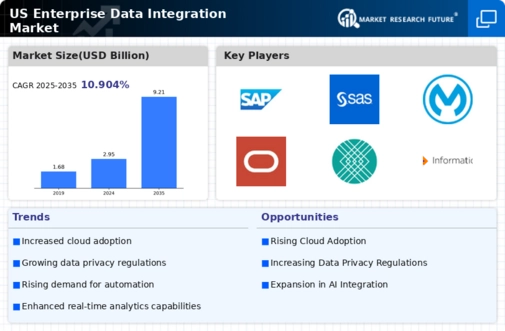The US Enterprise Data Integration Market is characterized by a dynamic landscape where numerous players vie for dominance in providing seamless data connectivity and management solutions. With the increasing emphasis on data-driven decision-making and the subsequent demand for real-time access to data, enterprises are turning to data integration platforms to streamline operations, enhance efficiency, and maintain competitive advantage. The market is fragmented, featuring both established global entities and innovative niche players, each bringing unique offerings and capabilities to the table.
As organizations look to integrate disparate data sources, optimize workflows, and elevate customer experiences, understanding the competitive insights within this sector is critical for stakeholders aiming to capitalize on emerging opportunities.SAP stands as a formidable player in the US Enterprise Data Integration Market, leveraging its extensive suite of enterprise applications to foster robust data integration capabilities. Known for its comprehensive approach, SAP enables organizations to connect various data sources seamlessly while providing tools that enhance data governance and compliance. The company's strengths lie in its deep-rooted presence within large enterprises that seek integrated solutions across business units.
Additionally, SAP’s commitment to consistent innovation, particularly in cloud services and advanced analytics, fortifies its position by allowing for greater scalability and flexibility in data integration efforts. The organization continuously invests in enhancing its platforms to meet the ever-evolving needs of its clientele, thus reinforcing customer loyalty in a competitive landscape.Dell Boomi occupies a unique niche within the US Enterprise Data Integration Market, focusing on delivering cloud-based integration solutions that facilitate rapid deployment and collaboration across systems.
With its comprehensive integration platform as a service (iPaaS), Dell Boomi stands out for its user-friendly interface and robust capabilities for connecting applications and data sources across hybrid environments. The company's strengths include a strong emphasis on customer engagement and adaptability in meeting diverse integration needs, which is critical for businesses that prioritize agility. Dell Boomi has actively pursued growth through strategic partnerships and acquisitions, broadening its service offerings and technological reach. The firm also focuses on features such as API management and data orchestration, catering specifically to modern enterprise requirements, thereby enhancing its competitive edge in the market.
Through these initiatives, Dell Boomi has fortified its presence and appeal among US organizations looking for innovative solutions to facilitate seamless data integration.
























